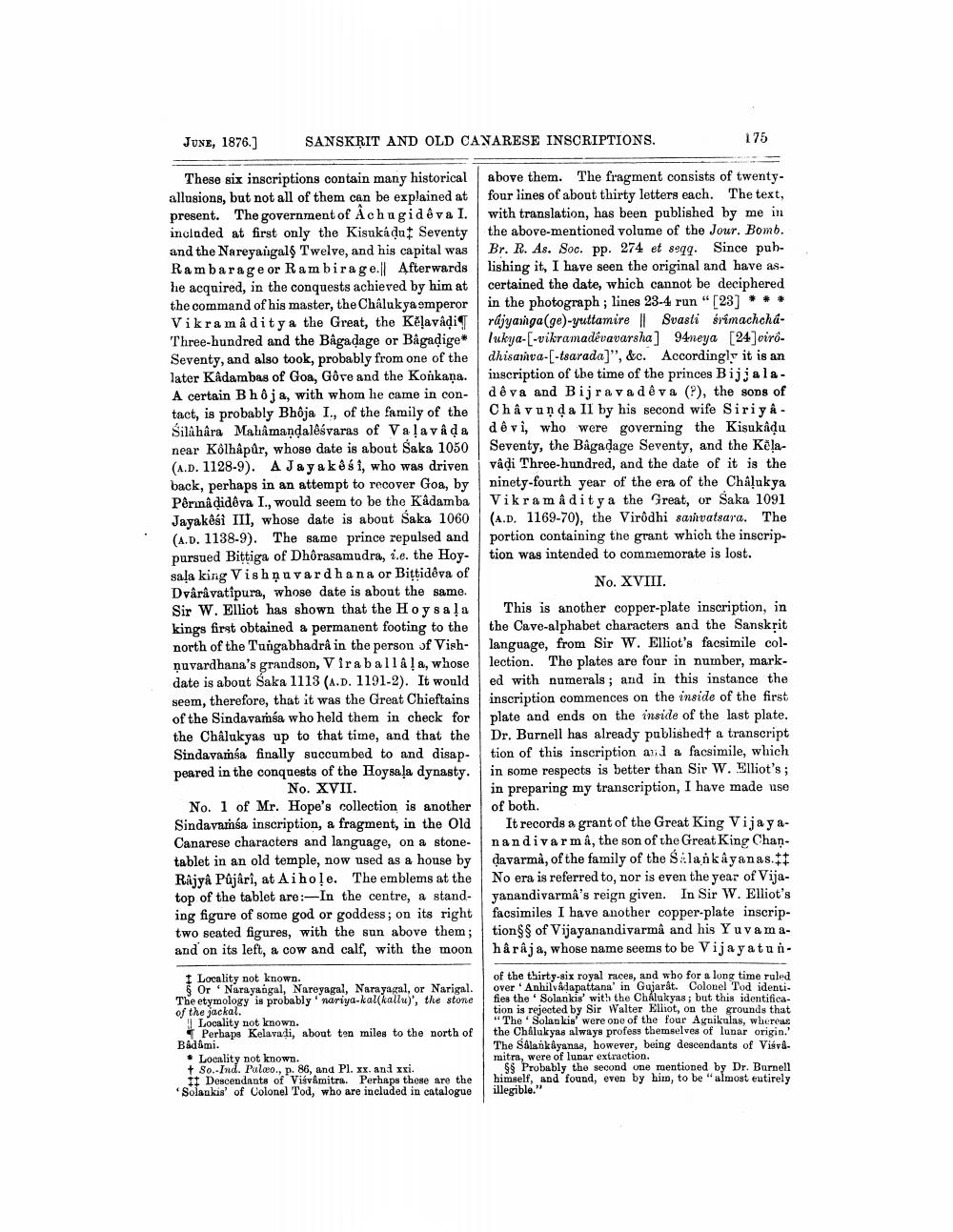________________
SANSKRIT AND OLD CANARESE INSCRIPTIONS.
JUNE, 1876.]
These six inscriptions contain many historical allusions, but not all of them can be explained at present. The government of Achugidêva I. included at first only the Kisukáḍut Seventy and the Nareyangals Twelve, and his capital was Rambarageor Rambirage. Afterwards he acquired, in the conquests achieved by him at the command of his master, the Châlukya emperor Vikramaditya the Great, the Kelavadi Three-hundred and the Bâgaḍage or Bâgadige Seventy, and also took, probably from one of the later Kadambas of Goa, Gôve and the Konkana. A certain B hôja, with whom he came in contact, is probably Bhôja I., of the family of the Silahara Mahamandalêsvaras of Valavâda near Kolhapûr, whose date is about Saka 1050 (A.D. 1128-9). A Jayakêsi, who was driven back, perhaps in an attempt to recover Goa, by Pêrmâ didêva I., would seem to be the Kâdamba Jayakési III, whose date is about Saka 1060 (A.D. 1138-9). The same prince repulsed and pursued Bittiga of Dhôrasamudra, i.e. the Hoysala king Vishnuvardhana or Bittidêva of Dvârâvatipura, whose date is about the same. Sir W. Elliot has shown that the Hoysala kings first obtained a permanent footing to the north of the Tungabhadrâ in the person of Vishnuvardhana's grandson, Vira ballala, whose date is about Saka 1113 (A.D. 1191-2). It would seem, therefore, that it was the Great Chieftains of the Sindavamsa who held them in check for the Chalukyas up to that time, and that the Sindavamsa finally succumbed to and disappeared in the conquests of the Hoysala dynasty. No. XVII.
No. 1 of Mr. Hope's collection is another Sindavamsa inscription, a fragment, in the Old Canarese characters and language, on a stonetablet in an old temple, now used as a house by Rajya Půjârî, at Aihole. The emblems at the top of the tablet are:-In the centre, a standing figure of some god or goddess; on its right two seated figures, with the sun above them; and on its left, a cow and calf, with the moon
Locality not known.
Or Narayangal, Nareyagal, Narayagal, or Narigal. The etymology is probably nariya-kal(kallu)', the stone of the jackal.
Locality not known.
Perhaps Kelavadi, about ten miles to the north of Badami.
Locality not known.
So.-Ind. Palæo., p. 86, and Pl. xx. and xxi.
Descendants of Visvamitra. Perhaps these are the 'Solankis' of Colonel Tod, who are included in catalogue
175
above them. The fragment consists of twentyfour lines of about thirty letters each. The text, with translation, has been published by me in the above-mentioned volume of the Jour. Bomb. Br. R. As. Soc. pp. 274 et seqq. Since publishing it, I have seen the original and have ascertained the date, which cannot be deciphered in the photograph; lines 23-4 run "[23] rajyamga(ge)-yuttamire || Svasti śrimachchálukya-[-vikramadevavarsha] 94neya [24]virodhisamva-[-tsarada]", &c. Accordingly it is an inscription of the time of the princes Bijjaladê va and Bijrava dêva (?), the sons of Châ vunda II by his second wife Siriyâdêvi, who were governing the Kisukâdu Seventy, the Bâgadage Seventy, and the Kelavâdi Three-hundred, and the date of it is the ninety-fourth year of the era of the Chalukya Vikramaditya the Great, or Saka 1091 (A.D. 1169-70), the Virôdhi samvatsara. The portion containing the grant which the inscription was intended to commemorate is lost.
No. XVIII.
This is another copper-plate inscription, in the Cave-alphabet characters and the Sanskrit language, from Sir W. Elliot's facsimile collection. The plates are four in number, marked with numerals; and in this instance the inscription commences on the inside of the first plate and ends on the inside of the last plate. Dr. Burnell has already publishedt a transcript. tion of this inscription and a facsimile, which in some respects is better than Sir W. Elliot's; in preparing my transcription, I have made use of both.
It records a grant of the Great King Vijayanandivarm â, the son of the Great King Chandavarmà, of the family of the Slankayanas. No era is referred to, nor is even the year of Vijayanandivarmâ's reign given. In Sir W. Elliot's facsimiles I have another copper-plate inscription§§ of Vijayanandivarmâ and his Yuvamahârâja, whose name seems to be Vijayatun
of the thirty-six royal races, and who for a long time ruled over Anhilvådapattana' in Gujarât. Colonel Tod identifies the Solankis' with the Chalukyas; but this identification is rejected by Sir Walter Elliot, on the grounds that "The Solankis' were one of the four Agnikulas, whereas the Chalukyas always profess themselves of lunar origin.' The Sâlankayanas, however, being descendants of Viśvåmitra, were of lunar extraction.
§§ Probably the second one mentioned by Dr. Burnell himself, and found, even by him, to be "almost entirely illegible."




